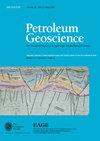北海北部Aurora CO2储存场的结构特征和跨断层密封性评估
IF 2.1
4区 地球科学
Q3 GEOSCIENCES, MULTIDISCIPLINARY
引用次数: 0
摘要
断层在许多潜在的CO2储存场所发挥着重要作用,因为它们可以充当流体流动的管道或屏障。为了有助于评估北海北部的Aurora存储场地,我们对取代下侏罗纪存储综合体的跨断层密封进行了结构表征和评估。我们发现,一阶断层主要呈N–S走向,W倾斜,其凸起大于初级密封层的厚度(>85 m)。相反,二阶断层具有较低的落差(15–50 m)和可变的走向和倾斜方向。由于储集复合体的倾斜,注入的CO2可能在其下盘一侧遇到一阶Svartalv断层带之前向北迁移,该断层带将储集单元与较年轻的富砂单元并置。然而,在储存复合体的深度处,页岩泥比值超过0.30,这表明可能存在断层膜密封。此外,沿Svartalv断层带,二阶NE向倾斜断层形成了并列密封,并在某些地方形成了小型构造圈闭(24-48 m)。总的来说,我们认为Aurora储存场地内的断层可以为羽流迁移提供障碍,使更多的CO2被捕获,从而增加储存容量。本文是能源地球科学系列的一部分,可在https://www.lyellcollection.org/cc/energy-geoscience-series本文章由计算机程序翻译,如有差异,请以英文原文为准。
Structural characterization and across-fault seal assessment of the Aurora CO
2
storage site, northern North Sea
Faults play an essential role at many potential CO
2
storage sites because they can act as conduits or barriers to fluid flow. To contribute to the evaluation of the Aurora storage site in the northern North Sea, we perform a structural characterization and assessment of across-fault seals that displace the Lower Jurassic storage complex. We find that first-order faults are predominately N–S-striking, and W-dipping, with throws greater than the thickness of the primary seal (>85 m). In contrast, second-order faults have lower throws (15–50 m) and variable strike and dip directions. Due to the dip of the storage complex, injected CO
2
is likely to migrate northwards before encountering the first-order Svartalv Fault Zone on its footwall side, which juxtaposes the storage units against younger sand-rich units. However, shale gouge ratio values exceed 0.30 at the depth of the storage complex, suggesting that a fault membrane seal may be present. Furthermore, second-order NE-dipping faults create juxtaposition seals and, in places, small-scale structural traps (24–48 m) along the Svartalv Fault Zone. Overall, we suggest that faults within the Aurora storage site could provide barriers to plume migration allowing more CO
2
to become trapped, thereby increasing the storage capacity.
This article is part of the Energy Geoscience Series available at
https://www.lyellcollection.org/cc/energy-geoscience-series
求助全文
通过发布文献求助,成功后即可免费获取论文全文。
去求助
来源期刊

Petroleum Geoscience
地学-地球科学综合
CiteScore
4.80
自引率
11.80%
发文量
28
审稿时长
>12 weeks
期刊介绍:
Petroleum Geoscience is the international journal of geoenergy and applied earth science, and is co-owned by the Geological Society of London and the European Association of Geoscientists and Engineers (EAGE).
Petroleum Geoscience transcends disciplinary boundaries and publishes a balanced mix of articles covering exploration, exploitation, appraisal, development and enhancement of sub-surface hydrocarbon resources and carbon repositories. The integration of disciplines in an applied context, whether for fluid production, carbon storage or related geoenergy applications, is a particular strength of the journal. Articles on enhancing exploration efficiency, lowering technological and environmental risk, and improving hydrocarbon recovery communicate the latest developments in sub-surface geoscience to a wide readership.
Petroleum Geoscience provides a multidisciplinary forum for those engaged in the science and technology of the rock-related sub-surface disciplines. The journal reaches some 8000 individual subscribers, and a further 1100 institutional subscriptions provide global access to readers including geologists, geophysicists, petroleum and reservoir engineers, petrophysicists and geochemists in both academia and industry. The journal aims to share knowledge of reservoir geoscience and to reflect the international nature of its development.
 求助内容:
求助内容: 应助结果提醒方式:
应助结果提醒方式:


